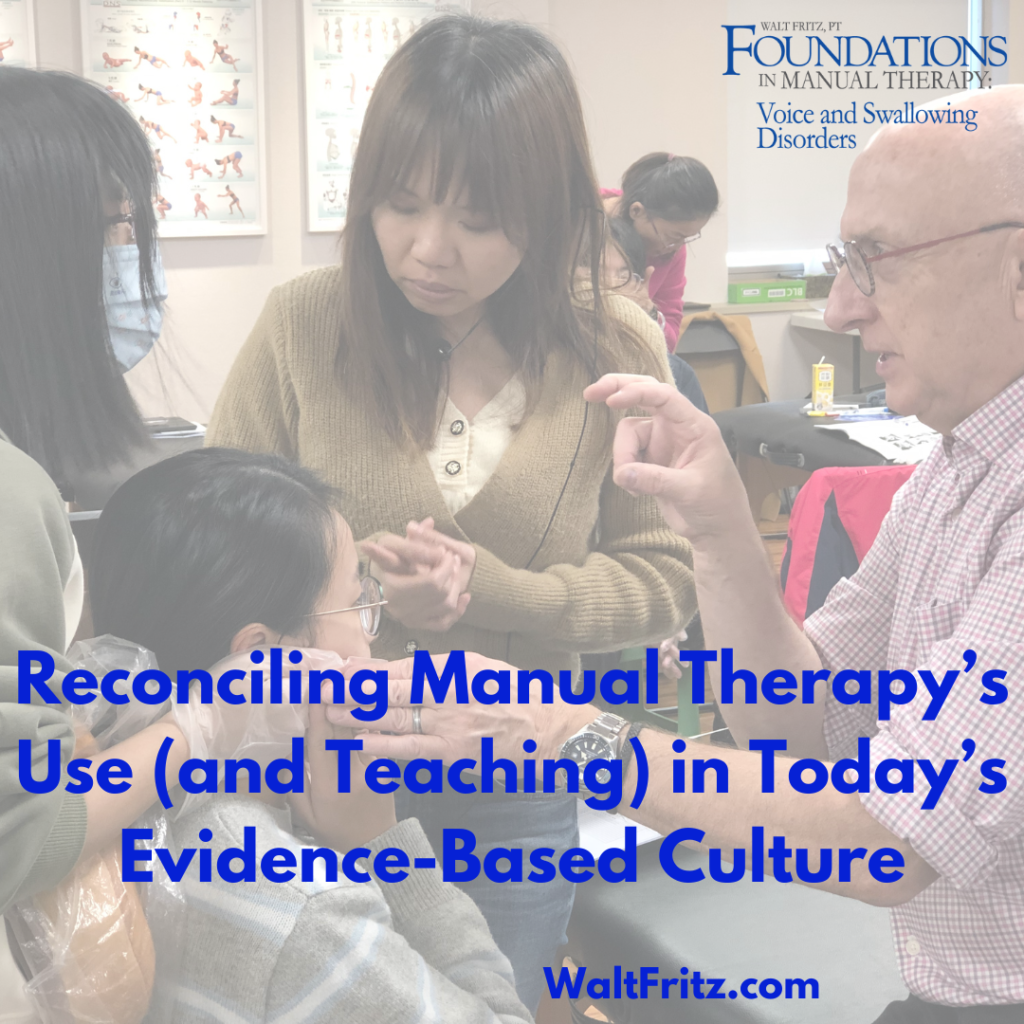Reconciling Manual Therapy’s Use (and Teaching) in Today’s Evidence-Based Culture

Manual therapies have been minimized over the past few decades (some say demonized), some of which is well-deserved. Reliance on passive interventions of any type disempowers the patient and can potentially create dependency on the clinician and their services. Another negative is the many multi-tiered training models that draw therapists into the rabbit hole of “expertise.” However, manual therapies have been shown to have value with specific diagnoses and with certain patient profiles.
Chad E. Cook, PT, PhD, FAPTA, wrote an excellent article titled “The demonization of manual therapy,” which attempts to balance public and professional views of manual therapy’s place in today’s treatment models. (Cook, C. E. (2021). The demonization of manual therapy. Muskuloskelettale Physiotherapie, 25, 125-132.). On the blog PhysioNetwork, Stephen Collins speaks to the myths of manual therapy in physical therapy practice (https://www.physio-network.com/blog/myths-manual-therapy/).
As a PT for nearly 40 years, I, unfortunately, entered the manual therapy world via a tribalistic myofascial release model. I fell deep into that rabbit hole and only emerged through the help of the now-defunct forum site, SomaSimple. Years later, I still value the style of work taught in those MFR classes, but with an explanatory narrative that makes more sense in today’s evidence-driven world. There are dozens (hundreds?) of modalities competing for our CE dollar, each making claims that seem difficult to prove. Yet once we succeed, we often lose track of those questionable narratives, bully our way forward, and advertise the benefits of modality XYZ.
Many years ago, when the SomaSimple episode was fresh, I began looking for and at the common denominators of the various manual therapies and learning about the therapeutic relationship and shared decision-making (SDM). SDM is becoming a common theme in healthcare, but the PT profession seems to steer away from it. Listening to a podcast recently, given by a few PTs I respect, there was a conversation about SDM, and, in a rather dismissive manner, one of the speakers stated, “Well, it’s not like we can allow our patients to choose their exercises.” That got a laugh out of both PTs, and they were right at some level. We are experts in musculoskeletal-related pain and movement disorders. But should we be solely responsible for what we prescribe to others? How are patient preferences and values built into a model where we, the clinician, call all the shots? Autonomy-building has been at the core of our profession for years, but how do we accomplish that? Evidence shows that if our recommendations align with patient preferences and values, outcomes can improve (Patient’s perception of autonomy support and shared decision making in physical therapy. Br Dent J 220, 57 (2016). https://doi.org/10.1038/sj.bdj.2016.54).
Manual therapy has been a clinician-as-expert model from its inception and continues to be that way today. The clinician knows the evaluation methods, understands how to interpret them, and decides on the proper interventions. Or at least that’s what most are taught. A shared decision-making approach to manual therapy is what I now teach. It is not another acronym modality, but a workshop intended to teach SDM to clinicians in the context of the slow, sustained manual therapy approach I’ve used for decades. The skills learned in this class are broadly applicable across the spectrum of exercise and manual therapy interventions.
For the past decade, I’ve shifted much of my teaching attention to speech-language pathologists, who incorporate manual therapy for various issues relating to head/neck cancer rehabilitation, voice disorders, performing voice, oral motor delays and problems, and more. I’ve published an article discussing the need to update narratives regarding laryngeal manual therapies (Fritz W. (2024). The mechanism of action for laryngeal manual therapies: the need for an update. Current opinion in otolaryngology & head and neck surgery, 32(3), 151–155. https://doi.org/10.1097/MOO.0000000000000966). As Chad Cook implies in his paper, manual therapy should never be a standalone intervention. It is best embedded in movement and education, and my approach aligns with these ideals.
If you’ve made it this far down in my post, kudos!
While I continue to enjoy those classes, I’ve had requests from a few facilities to teach a more general seminar again. After some time away from teaching PTs, I’ve built in a few classes over the next year, and I hope you will consider joining me. PT CEUs are currently (or will be) approved for Alaska and Florida, with others available on request, including OT CEUs. The classes are approved by NCBTMB. The Foundations in Manual Therapy: Whole Body Seminar is a 2-day workshop highlighting SDM. It will feature a lot of “non-denominational” manual therapy suitable for PT, OT, and MT. I’m happy to answer any questions you have about this class or my approach to teaching and applying manual therapy. You can read more details at www.WaltFritz.com.

Sorry, comments are closed for this post.